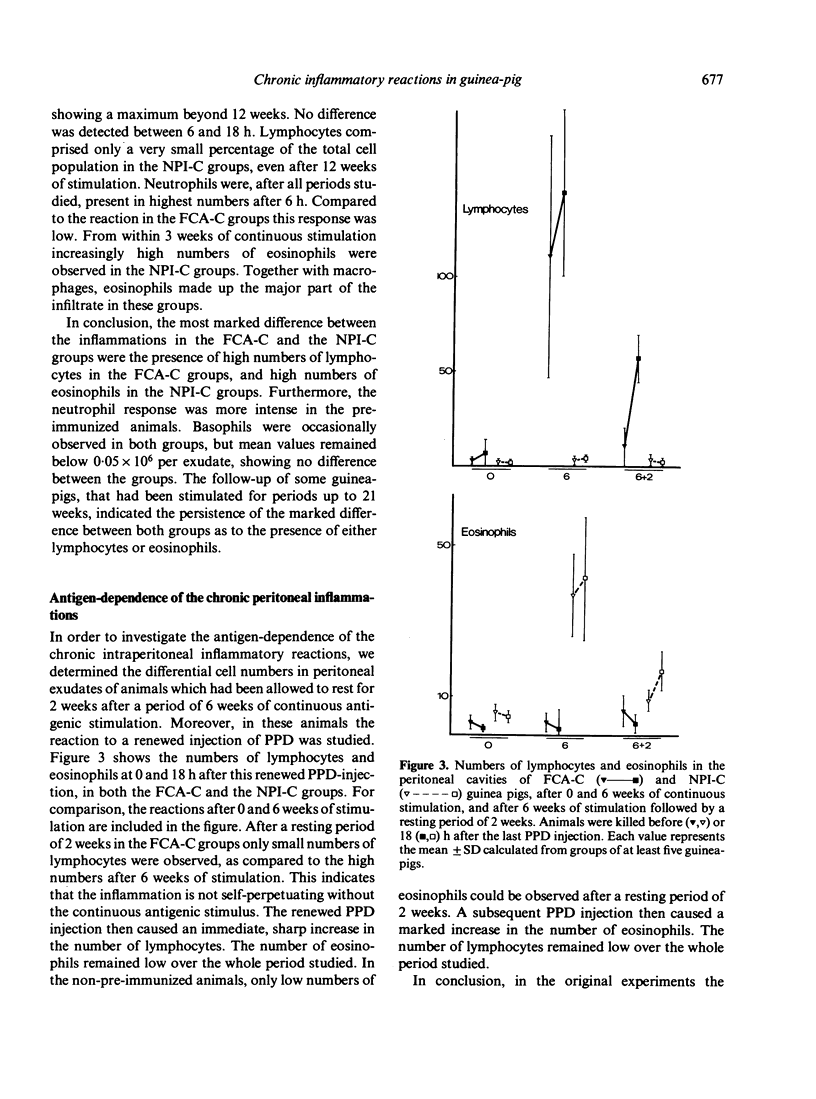Abstract
A chronic inflammation model is described which allows the study of the relationship between the level of specific cell-mediated and humoral immunity to the triggering antigen, and the presence of cells or mediators in the inflammatory exudate. In the present study special attention is paid to the participation of lymphocytes and eosinophils. Normal or FCA-pre-immunized guinea-pigs received repeated intraperitoneal injections with PPD for periods up to 21 weeks. In non-pre-immunized animals the inflammation was characterized by a strong accumulation of eosinophils, whereas only a few lymphocytes were present. In contrast, the FCA-pre-immunized guinea-pigs showed a strong lymphocytic accumulation in the absence of eosinophils. Both peritoneal inflammations were shown to remain dependent on the continuous PPD administration. Therefore, the participation of either lymphocytes or eosinophils could be directly correlated to differences in the specific immune status. Both experimental groups developed similar strong anti-PPD antibody responses as assessed by haemagglutination and passive cutaneous anaphylaxis. Only the FCA-pre-immunized guinea-pigs, however, showed strong cell-mediated immunity. The development of CMI to the continuously administered antigen appears to be a prerequisite for the accumulation of lymphocytes, while it seems to prevent antibody-mediated eosinophil accumulation.
Full text
PDF








Selected References
These references are in PubMed. This may not be the complete list of references from this article.
- BOYDEN S. V. CYTOPHILIC ANTIBODY IN GUINEA-PIGS WITH DELAYED-TYPE HYPERSENSITIVITY. Immunology. 1964 Jul;7:474–483. [PMC free article] [PubMed] [Google Scholar]
- BOYDEN S. V. The adsorption of proteins on erythrocytes treated with tannic acid and subsequent hemagglutination by antiprotein sera. J Exp Med. 1951 Feb;93(2):107–120. doi: 10.1084/jem.93.2.107. [DOI] [PMC free article] [PubMed] [Google Scholar]
- Berry H., Willoughby D. A., Giroud J. P. Evidence for an endogenous antigen in the adjuvant arthritic rat. J Pathol. 1973 Dec;111(4):229–238. doi: 10.1002/path.1711110403. [DOI] [PubMed] [Google Scholar]
- Boros D. L. Granulomatous inflammations. Prog Allergy. 1978;24:183–267. doi: 10.1159/000401230. [DOI] [PubMed] [Google Scholar]
- Clark R. A., Gallin J. I., Kaplan A. P. The selective eosinophil chemotactic activity of histamine. J Exp Med. 1975 Dec 1;142(6):1462–1476. doi: 10.1084/jem.142.6.1462. [DOI] [PMC free article] [PubMed] [Google Scholar]
- Cohen S., Ward P. A. In vitro and in vivo activity of a lymphocyte and immune complex-dependent chemotactic factor for eosinophils. J Exp Med. 1971 Jan 1;133(1):133–146. doi: 10.1084/jem.133.1.133. [DOI] [PMC free article] [PubMed] [Google Scholar]
- Cohen S., Ward P. A., Yoshida T., Burek C. L. Biologic activity of extracts of delayed hypersensitivity skin reaction sites. Cell Immunol. 1973 Dec;9(3):363–376. doi: 10.1016/0008-8749(73)90051-8. [DOI] [PubMed] [Google Scholar]
- DUMONDE D. C., GLYNN L. E. The production of arthritis in rabbits by an immunological reaction to fibrin. Br J Exp Pathol. 1962 Aug;43:373–383. [PMC free article] [PubMed] [Google Scholar]
- Fox A., Glynn L. E. Is persisting antigen responsible for the chronicity of experimental allergic arthritis? Ann Rheum Dis. 1977 Feb;36(1):34–38. doi: 10.1136/ard.36.1.34. [DOI] [PMC free article] [PubMed] [Google Scholar]
- Kay A. B., Shin H. S., Austen K. F. Selective attraction of eosinophils and synergism between eosinophil chemotactic factor of anaphylaxis (ECF-A) and a fragment cleaved from the fifth component of complement (C5a). Immunology. 1973 Jun;24(6):969–976. [PMC free article] [PubMed] [Google Scholar]
- Kay A. B., Stechschulte D. J., Austen K. F. An eosinophil leukocyte chemotactic factor of anaphylaxis. J Exp Med. 1971 Mar 1;133(3):602–619. doi: 10.1084/jem.133.3.602. [DOI] [PMC free article] [PubMed] [Google Scholar]
- Kay A. B. Studies on eosinophil leucocyte migration. II. Factors specifically chemotactic for eosinophils and neutrophils generated from guinea-pig serum by antigen-antibody complexes. Clin Exp Immunol. 1970 Nov;7(5):723–737. [PMC free article] [PubMed] [Google Scholar]
- König W., Czarnetzki B. M., Lichtenstein L. M. Eosinophil chemotactic factor (ECF). III. Generation in human peripheral leukocytes. Int Arch Allergy Appl Immunol. 1978;56(4):364–375. doi: 10.1159/000232043. [DOI] [PubMed] [Google Scholar]
- LITT M. Studies in experimental eosinophilia. I. Repeated quantitation of peritoneal eosinophilia in guinea pigs by a method of peritoneal lavage. Blood. 1960 Sep;16:1318–1329. [PubMed] [Google Scholar]
- Loewi G. Experimental immune inflammation in the synovial membrane. I. The immunological mechanism. Immunology. 1968 Sep;15(3):417–427. [PMC free article] [PubMed] [Google Scholar]
- Moore D. L., Grove D. I., Warren K. S. The Schistosoma mansoni egg granuloma: quantitation of cell populations. J Pathol. 1977 Jan;121(1):41–50. doi: 10.1002/path.1711210107. [DOI] [PubMed] [Google Scholar]
- Noordhoek J., Bonta I. L. Anti-inflammatory mechanism of inflamed-tissue factor in hind-paw inflammation by carrageenin and kaolin. Arch Int Pharmacodyn Ther. 1973 Dec;206(2):394–396. [PubMed] [Google Scholar]
- OVARY Z., BIER O. G. Quantitative studies on passive cutaneous anaphylaxis in the guinea pig and its relationship to the Arthus phenomenon. J Immunol. 1953 Jul;71(1):6–11. [PubMed] [Google Scholar]
- Parish W. E. Eosinophilia. I. Eosinophilia in guinea-pigs mediated by passive anaphylaxis and by antigen-antibody complexes containing homologous IgG1a and IgG1b. Immunology. 1972 Jun;22(6):1087–1098. [PMC free article] [PubMed] [Google Scholar]
- Sonozaki H., Cohen S. The macrophage disappearance reaction: mediation by a soluble lymphocyte-derived factor. Cell Immunol. 1971 Aug;2(4):341–352. doi: 10.1016/0008-8749(71)90069-4. [DOI] [PubMed] [Google Scholar]
- Turk J. L., Parker D. Sensitization with Cr, Ni and Zr salts and allergic type granuloma formation in the guinea pig. J Invest Dermatol. 1977 Jun;68(6):341–345. doi: 10.1111/1523-1747.ep12496465. [DOI] [PubMed] [Google Scholar]
- Ward P. A., Unanue E. R., Goralnick S. J., Schreiner G. F. Chemotaxis of rat lymphocytes. J Immunol. 1977 Aug;119(2):416–421. [PubMed] [Google Scholar]


